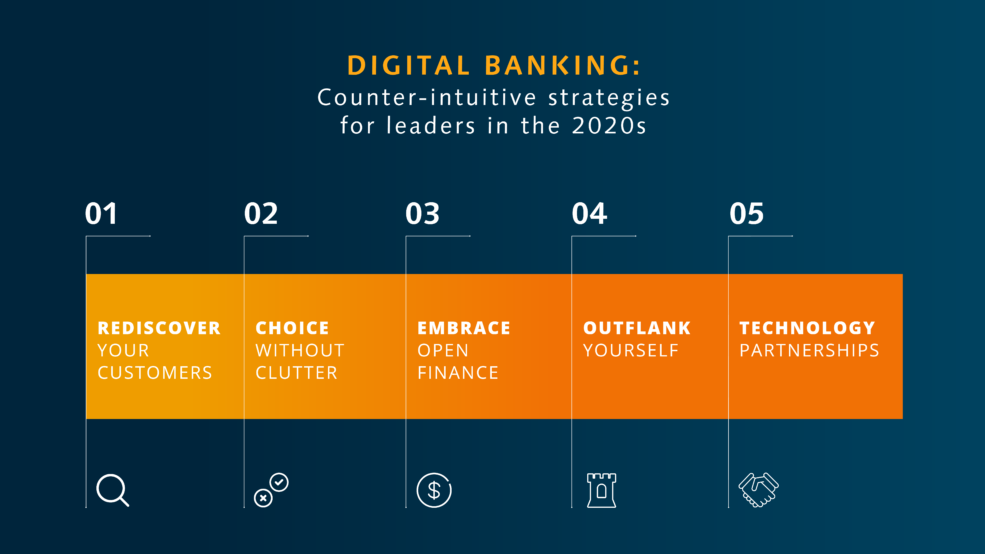
In order to cope with the positive but disruptive changes of the digital era, established financial institutions adopt strategies that intuitively seem right to them against the background of their business practices. However, operating principles and processes that have evolved over decades are often are far from optimal in the digital era. This article presents five counterintuitive approaches for established financial brands to consider, which may help them to gain more success from their digital strategies in the 2020s.
-
Instead of invisible internal tweaking, create visible improvements for customers
Established banks and wealth management firms spend a lot on technology, but this does not always correlate with value for the business. Under the surface, all but the newest firms struggle with the complexity and costs of hundreds of different software and IT systems which they have to maintain for day-to-day operations. This can result in financial institutions dedicating most of their technology budgets to the maintenance of their existing systems, instead of innovation. It’s important to assess this. Is the cost of legacy systems eating up the valuable resources that could otherwise be used to create improvements? Customers cannot see or feel “maintenance”: no amount of technical work, however essential, will add up to deliver the digital user experience that is needed these days to compete with the sleek offerings of the challengers.
Banks need to be much more aggressive about prioritising the delivery of improvements which are tangible for the end customer. Modernising underlying systems is important, but innovation is even more important – and, in order to be innovative, the existing resources must be radically redistributed. Moreover, a budget boost in this area will send a clear message to the company’s teams that rhetoric must turn into action that’s evaluated not only in internal technical terms, but in improved customer experience.
-
Offer choice instead of clutter
It is easier for established companies to add new products and services to their portfolio than to remove existing offerings. That’s why many established banks and wealth management firms have accumulated an immense array of accounts, cards, tariffs, price levels and services. It’s all built up, banks tell themselves, in the interest of the customers, because they appreciate this wide choice, don’t they? The truth is that customers quickly feel overwhelmed by too many options. It’s not choice: it’s clutter.
Financial institutions can only become faster and more innovative if they become leaner and more focused – in other words, if they radically reduce the number of options within their portfolio. It is therefore a counterintuitive strategy to simplify the customer journey as much as possible because simplicity means convenience, and convenience is the biggest driver of loyalty in the digital world. However, this is not to say one size fits all. Successful banks will still have to use technology to personalise user experiences instead of showing the same options to all customers.
-
Focus on open finance instead of a siege mentality
Established financial institutions have so far taken a defensive stance against open banking. Open banking is understood as being forced to share their greatest treasure – their customers – with potential competitors. For this reason, many banks consider it rational to slow-walk the opening of their systems, doing just enough to national regulation. This is a legacy thinking trap, too, because the real drivers of open finance will not be the regulators, but the demanding modern customers – and they know what they want: a banking experience that keeps up with their digital lifestyles.
The financial world of tomorrow is hyperconnected – thus it is better to become part of this ecosystem early on, and exploit it rather than fight it. The key to future success will be to find intelligent ways to use third party data and functionality rather than merely making your data available to third parties. The more you experiment with the new possibilities of open finance, the more successful you will be.
-
Challenge the challengers instead of going into rigor mortis
Established financial brands often shy away from challenger-style innovations because they fear that radical changes could jeopardise their institution’s brand, reputation and identity. In view of this risk, they prefer doing “business as usual” and build a conservative self-image that seeks to justify doing things in cautious, slow, manual ways. Banks and wealth management firms which follow this path want to risk as little as possible – yet they are possibly risking everything.
A counterintuitive strategy for banks is to investigate what exactly makes the challengers so successful – and then launch a semi-independent flanker brand (also known as successor brand) to be able to experiment with new technologies, new ways of thinking and new customer segments which are independent of the main brand. The big advantage of this: for a flanker brand, moving fast does not always have to be risky and expensive.
-
Focus on innovations in “Fin” instead of reinventing “Tech”
Fintechs are often by nature more “tech” than “fin”. They impress above all with their technological competence, their customer-oriented design thinking and their ability to find new solutions for old problems. Many established financial institutions believe that they have to become Silicon Valley style technology companies themselves in order to be able to cope with the new digitally-native competitors. They are hiring hundreds of developers and building out their IT infrastructure – but is this really necessary? In fact, established financial brands should focus on their core competencies: the development and distribution of financial products and services.
Technology is only a means to an end and can be outsourced by banks to a strong ecosystem of specialised financial technology providers – another way to become faster, more flexible and more successful in the digital age.
This article originally appeared in The Fintech Power 50 Annual Guide 2020: https://issuu.com/thepower50/docs/the_fintech_power_50_annual_guide_2020
The Fintech Power 50 is a group of the most influential and up-and-coming technology brands in banking, wealth management, and payments.




